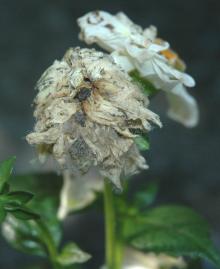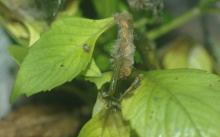See:
Greenhouse Plants, Ornamental - Gray Mold
Cause Botrytis cinerea, a fungus. During cloudy weather and high humidity, the fungus occurs widely on soft, succulent plant material of a wide variety of hosts, building up rapidly on tender flower petals and rapidly growing stems and leaves.
Symptoms Young dahlia shoots and flowering buds may become infected, resulting in fading and browning petals and destruction and death of other infected parts. Buds may be attacked by a soft rot and become covered with a grayish powdery fungal growth. Flowers are frequently blighted. Older tissues are more susceptible to infection than younger, more vigorous tissues. In storage, tubers take on a moist, water-soaked appearance, developing gray spore masses.
Cultural control
- Maintain a steady, relatively dry environment by keeping greenhouse humidity below 90%, increasing spacing between plants for good air circulation, and taking care not to splash water on foliage during watering. Heating the greenhouse at night (especially for zero or negative DIF) or venting around sunset may be necessary. Heating in the morning before sunup can also help prevent dew formation as air temperature increases faster than the temperature of plant parts. If using DROP or DIP for size control, do not let humidity rise above 90%.
- Remove and destroy all infected plant tissues, particularly old flowers and infected leaves.
- Bury or completely compost plant residue.
- Use pathogen-free tubers for planting.
Chemical control Focus on cultural control methods, but can use foliar sprays. Tank-mix and/or alternate products from different groups with different modes of action to prevent the buildup of resistant fungi. Limit the use of any one group during the growing season.
- Astun at 10 to 17 fl oz/100 gal water. Group 7 fungicide. 12-hr reentry.
- Chipco 26019 FLO at 1 to 2.5 quarts /100 gal water. Group 2 fungicide. 12-hr reentry.
- Decree 50 WDG at 0.75 to 1.5 lb/100 gal water. Group 17 fungicide. 12-hr reentry.
- Mancozeb-based products can be used as mixing partners and provide some protection. Group M3 fungicides. 24-hr reentry.
- Fore 80 WP at 1.5 lb/100 gal water plus a spreader-sticker.
- Protect DF at 1 to 2 lb/100 gal water plus 2 to 4 oz spreader-sticker.
- Medallion WDG at 2 to 4 oz/100 gal water. Use with oils or adjuvants may damage plant. Group 12 fungicide. 12-hr reentry.
- Nu-Cop 50 DF at 1 lb/100 gal water. May discolor blooms. Group M1 fungicide. 48-hr reentry.
- OHP 6672 4.5 F at 10 to 14.5 fl oz/100 gal water plus another fungicide. Group 1 fungicide. 12-hr reentry.
- Pageant at 12 to 18 oz/100 gal water. Do not use with organosilicone-based adjuvants. Group 7 + 11 fungicide. 12-hr reentry.
- Palladium at 4 to 6 oz/100 gal water. Avoid excessive runoff to small plants, which may result in stunting and/or chlorosis. Group 9 + 12 fungicide. 12-hr reentry.
- Phyton 27 at 1.3 to 2 fl oz/10 gal water. Group M1 fungicide. 48-hr reentry.
- Regime at 20.5 to 45.7 fl oz/A. Reapply if rain occurs within 12 hours of original application. Group BM01 fungicide. 4-hr reentry.
- Spirato GHN at 2 to 4 fl oz/100 gal water. Use with oils or adjuvants may cause plant damage. Group 12 fungicide. 12-hr reentry.
- Terraguard SC at 4 to 8 fl oz/100 gal water. Group 3 fungicide. 12-hr reentry.
- Ziram 76 DF at 1.5 to 2 lb/100 gal water. Group M3 fungicide. 48-hr reentry.
Biological control
- LALStop G46 WG (Clonostachys rosea [formerly Gliocladium catenulatum] strain J1446) at 0.13 oz/1 gal water. Do not use with other products in the tank. 4-hr reentry. O
Reference Gleason, M.L., Daughtrey, M.L., Chase, A.R., Moorman, G.W., and Mueller, D.S. 2009. Diseases of Herbaceous Perennials. APS Press, St. Paul, MN.




